

NORTH CAROLINA
April 2002

1 of 1


NORTH CAROLINA
April 2002


1 of 1
This was a great month for herping. First, my brother Ron and I spent a week in the tropical rainforests of Costa
Rica. Then I drove down to Florida for a few days in the pines and palmetto of Apalachicola and Gulf Hammock.
Finally, on my drive back north I stopped off again in North Carolina. Ron and I had an invitation to join some fellow
herpers for a day in the field Down East, so off we headed to flip tin and search abandoned shacks.
Our first stop is to release a beautiful Corn Snake our host had captured on an earlier visit. Dan is a biology
teacher and had kept this snake to show his class, but it was now time to let it go, so we return to the same spot where
it was originally found. As I watch it crawl away, Dan and his friend are already turning sheets of tin, looking for the
next one. They attack a large pile nearby, flipping one layer after another, when someone calls out, “Corn Snake!” and
we see a tail disappearing under the tin.
They finally get to the very bottom piece, flip it, and are rewarded with another snake as beautiful as the one we
returned. But then someone says, “That’s not the one I saw crawl under the tin.” We stop to look around, and sure
enough, heading away from the pile is another Corn Snake. For a moment I think it’s the snake we had just released,
but that one is continuing in the opposite direction. So I guess the place is literally crawling with Corn Snakes.
As the day grows hotter we decide to concentrate on wet places in the shade, namely, drainage ditches bordered
by trees. I learn an interesting technique for shallow, weedy places. Stepping into the water, we dredge the edges with
our wading boots, kicking soccer-style and launching wet debris up onto the sides of the ditch. We then wait to see if
anything flops about in all the muck and litter. Fish, frogs, crawfish, and other startled residents go flying up the bank
and sliding back down again. Our real hope is for a siren or amphiuma, but instead we stir up a pair of very pretty
juvenile Carolina Cottonmouths.
Later on we try the same technique near a bridge where the water has spread out among weeds along the side of
a highway. By this time my brother is a pro (must have been his early interest in soccer), but when he succeeds in
splashing something out of the water that’s slimy and slithering, I don’t know who is more surprised, Ron or the siren
that slips through his fingers! Gone for good I assume, but Ron and Dan are persistent. Five minutes of searching and
sloshing and no sign, then suddenly a glimpse, a grab, and a curse as it once again slides away. This goes on for about
20 minutes, but finally, it lands in the net and stays. First one we ever caught, and we are right well pleased.
A sad postscript. Ron brought the siren home, where it thrived for six months before meeting an unlikely end.
As he lamented in his e-mail:
Bad news. We came back last week to find that the racoons had gotten into the house and massacred everything in that
aquarium. The furry bastards didn't even eat the siren, just bit it and left it for dead. The mud minnows we had collected at
Lake Mattamuskeet a few years ago as well. I was majorly bummed. The siren was probably a Siren intermedia (Lesser
Siren), based on the size and the spotting on the head. I was never able to count costal grooves, though, so it may have just
been a small Siren lacertina (Greater Siren). It was beautiful and doing very well, taking earthworms by hand
―
suck ‘em
down like spaghetti. It had gotten to the point where it would come out and follow your finger around in anticipation of food.
Not the usual cause of death for captive herps.
Another first for me was this beautiful Mole Kingsnake that Dan grabs going down a hole after he flips a board.
Usually they’re more of a brown coloration, but this one is an example of the red-phase variety. Too bad the snake is
opaque, getting ready to shed, otherwise the color would have been even richer and more glossy.
It’s just before sunset so we pull away from the Mole King spot and begin road cruising. We hadn’t gone but a
couple hundred yards when yet another Corn Snake crosses our path, this one the biggest and reddest we saw all day
(altogether we counted eight, including DORs).
Later that evening we stop to hike back through some woods where there is a pond, in hopes of hearing Pine
Barrens Tree Frogs, but unfortunately they’re not calling tonight. We do find, however, a number of these blunt-faced,
cat-eyed, cartoonish-looking toads hopping about in the sandy soil of the forest floor. Once again, it’s a first for me in
the field.
There’s one more “first in the field” in store for me this night, in more ways than one. As we walk the sandy trail
back through the woods, I think I hear a faint noise on the ground just to the right of the path. It’s very quiet, but it has
that sound of something moving, something sliding.
I stop, turn my flashlight towards the nearby ground, and I discover to my delight that in the darkness, there
crawling along side of me, is a beautiful brown-banded snake. This is first time I have ever found a snake just by
hearing, rather than seeing, it move. And better than that, it’s my first-ever Copperhead! All in all, a very satisfying
way to cap off a great month of herping.

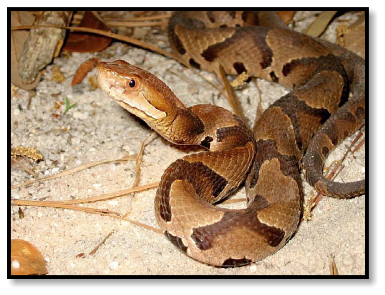
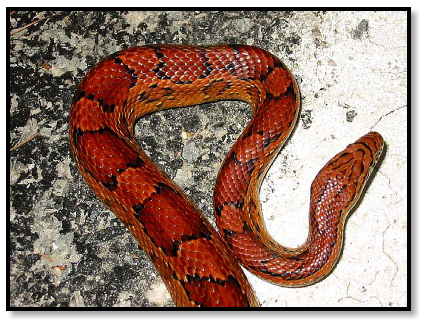
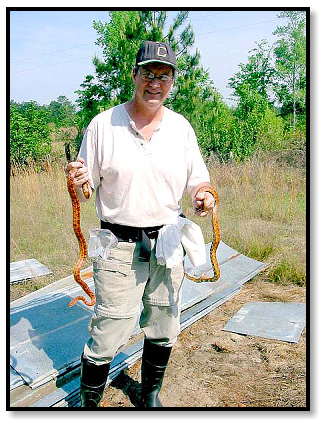
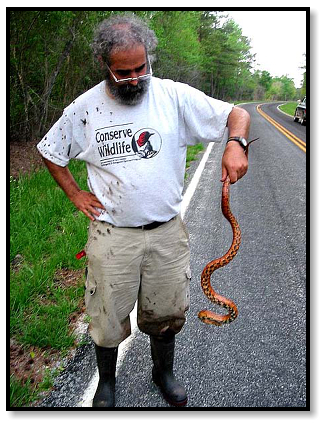
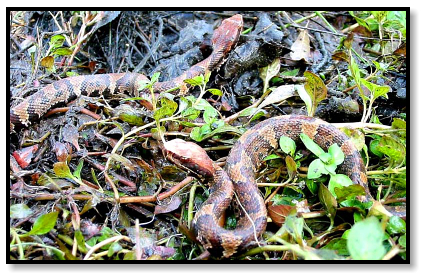
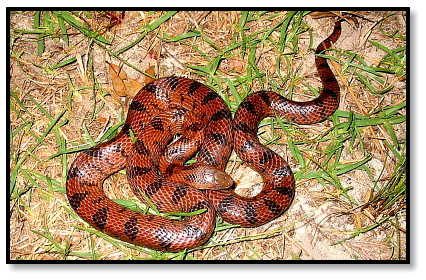
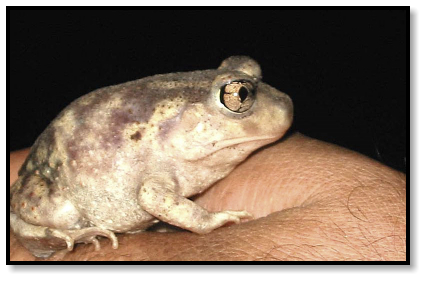
Eastern Cottonmouth Moccasin
Agkistrodon piscivorus piscivorus
Mole Kingsnake
Lampropeltis calligaster rhombomaculata
Corn Snake
Elaphe guttata guttata
Eastern Spadefoot Toad
Scaphiopus holbrookii holbrookii
Northern Copperhead
Agkistrodon contortrix mokasen







